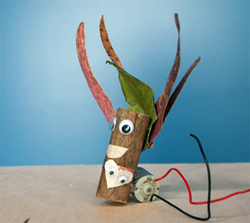The Harvard Family Research Project separated from the Harvard Graduate School of Education to become the Global Family Research Project as of January 1, 2017. It is no longer affiliated with Harvard University.

|
June 10, 2015 Federal Collaborations: Bringing Authentic STEM Experiences to High-Need Communities Through the Nation’s Largest Out-of-School ProgramEllen E. Lettvin
|
Related Resources
Engaging Families in Science, Technology, Engineering, and Math (STEM) Project-Based Learning
After School Programs in the 21st Century: Their Potential and What It Takes to Achieve It
Parents' Beliefs About Afterschool Programs and STEM Learning
In the report, America After 3 PM: Afterschool Programs in Demand, the Afterschool Alliance finds that:
- 65% of parents agree that afterschool programs can help children gain interest and skills related to STEM.
- 70% of parents agree that afterschool programs should offer opportunities to explore and engage in hands-on STEM learning.
- 53% of parents said that STEM learning opportunities were very important in their decision to select their child’s afterschool program.
FINE Newsletter, Volume VII, Issue 2
Issue Topic: Engaging Students in Afterschool Learning
Voices From the Field
STEM IN OUT-OF-SCHOOL TIME SETTINGS
There is considerable evidence that out-of-school time provides a critical pathway for engaging and interesting all students in science, technology, engineering, and mathematics (the STEM fields).1 This is a particularly effective strategy for engaging females and minorities, groups with the lowest levels of participation in the STEM fields. Inspiration and engagement are recognized as key factors to motivating student interest in these subjects; the informal learning context of out-of-school time can play a critical role in providing students with opportunities for hands-on exploration of science and engineering, forging connections to real-world applications that may not be available during school hours.2 Unfortunately, students who attend high-need schools, as well as their families, often have little or no access to high-quality STEM programs, particularly during out-of-school time.
The 21st Century Community Learning Centers program (21st CCLC), a $1.1 billion formula grant program run by the U.S. Department of Education, is the only federal funding source dedicated exclusively to supporting out-of-school programs. With a focus on serving students in low-income communities, 21st CCLC grants are awarded to state education agencies (SEAs) and funds are allocated according to the number of low-income students residing in the state. SEAs, in turn, manage statewide competitions and award grants to public or private entities—such as school districts or community- or religious-based organizations—to operate the programs locally. Grants made through the 21st CCLC program currently provide academic, artistic, and cultural enrichment opportunities, as well as a broad array of family engagement activities, to more than 1.6 million students at nearly 10,000 sites nationwide.
To capitalize on the role of out-of-school programs in engaging traditionally underrepresented communities in STEM, in 2011, 21st CCLC launched an initiative to incorporate high-quality STEM activities into program offerings. These programs have exposed students to hands-on, inquiry-based activities, involving them in new ways and enhancing their readiness for postsecondary education and for careers in the STEM fields. The 21st CCLC program has unparalleled potential for reaching traditionally underserved students, connecting the learning that takes place during the school day with real-world applications. Below, we highlight three federal interagency collaborations that bring engaging, hands-on experiences involving the STEM fields into out-of-school time learning and connect STEM professionals with students in high-need, low-performing schools.
THREE FEDERAL OUT-OF-SCHOOL STEM COLLABORATIONS
Collaboration with the National Aeronautics and Space Administration. In 2013, 21st CCLC piloted a STEM program in collaboration with the National Aeronautics and Space Administration (NASA) to bring authentic STEM content and experiences to students, directly connecting them with STEM professionals at a limited number of 21st CCLC sites. Building on the success of the program, in 2014 the partnership was expanded.
Today, the 21st CCLC‒NASA collaboration, which leverages activities developed through NASA’s Summer of Innovation program, provides middle school students with the opportunity to solve challenges that NASA scientists and engineers might encounter. NASA staff provide face-to-face and online professional development to the 21st CCLC staff, and throughout the program, both staff and students interact directly with NASA scientists and engineers via “virtual office hours.” Students learn firsthand about engineering design and practices, and educational pathways in STEM, as well as careers at NASA. Taking part in the pilot program were 20 21st CCLC sites in three states, and in 2015 there are nearly 80 21st CCLC participating sites in 10 states. Student teams tackle engineering challenges that include such activities as designing a heat shield for astronauts, developing games for astronauts to play aboard the International Space Station, and devising a pressure suit to protect astronauts in low-pressure environments.
 |
| Example of a Nature Bot students build by combining materials they collect from the outdoors with motors and other mechanical materials. Photo © 2015 the Exploratorium. |
Partnership with the Institute of Museum and Library Sciences. One of the new pilot programs is in partnership with the Institute of Museum and Library Sciences (IMLS). The program focuses on STEM-rich tinkering and making, and leverages enthusiasm for the “maker movement,” a powerful way to get young people engaged in STEM learning. This place-based collaboration links science-rich organizations (like local science museums and science youth-serving programs) with 21st CCLC sites. Currently, five science centers serve as activity hubs where staff from 21st CCLC sites receive training on how to lead tinkering and making activities, and where participating students have the chance to explore and learn firsthand about STEM by interacting with professionals with expertise in making. Students gain direct experience with scientific and engineering concepts, such as motors, friction and kinetic energy, as they create devices and objects through structured exploration. One example of the experience is a Nature Bot (see photo) activity in which students build robots using materials they collect from the outdoors, such as twigs and feathers, and combine these found objects with motors and other mechanical materials provided to them. Students are encouraged to experiment with different ways to connect their objects, documenting their progress along the way. This activity, and others conducted in this program, was developed by the Exploratorium, a San Francisco‒based science center with a history of innovation in maker education.
Pilot program with the National Park Service. Another pilot program, this one with the National Park Service (NPS), introduces environmental monitoring and citizen science activities to students in 21st CCLC programs at schools overseen by the Bureau of Indian Education (BIE) at 11 sites in six states. This effort is particularly important for American Indian communities, the most underrepresented group in the STEM fields. Similar to the work with IMLS, these programs are place-based, with national park units serving as activity hubs that are focused on introducing students to the natural resources in their region. Working with Hands on the Land, a national network of field classrooms and agency resources that connect students, teachers, families, and volunteers with public lands and waterways, NPS staff engage directly with students as subject-matter experts and provide in-person and online professional development to 21st CCLC staff.
REFLECTIONS
The interagency collaborations described here align with the Obama administration’s STEM education goals, leverage the unique assets of the collaborating agencies, and take advantage of the unequaled nationwide footprint of the 21st CCLC program. In addition to serving thousands of students nationwide, this interagency STEM initiative builds capacity within the local staff overseeing these programs. Through targeted professional development and technical assistance, staff receive the support and confidence needed to lead STEM activities3 in the future. To measure the impact of these programs and to understand how to replicate their successes, an external evaluation is being conducted of the impact of the NASA program, and implementation studies are currently under way for the two pilot ventures.
As the Obama administration noted in its 2010 report Prepare and Inspire, many American students suffer not only from a lack of proficiency but also from a lack of interest in the STEM fields. It is ironic, though, that while income inequality continues to grow in the U.S., the number of unfilled STEM jobs, which are among the highest-paying, also continues to grow. Additionally, over the next 20 years, global demand for STEM jobs is predicted to outpace supply.4 If we are to reverse this trend and motivate ALL students to develop interest and literacy in the STEM fields, we must provide them with firsthand experiences that foster creativity and problem-solving skills, and cultivate in these students a personal appreciation for the STEM fields. So far, demand for STEM-focused 21st CCLC STEM programs has far outpaced supply; plans are in the works to expand the offerings to include more locations and more federal partners, sharing high-quality STEM with thousands more high-need students.
About the Author:
Ellen Lettvin, Ph.D., is the Robert Noyce Senior Fellow in Informal STEM Learning, Office of Innovation and Improvement, U.S. Department of Education.
1 Fleming, N. (January 11, 2012). Out-of-school time drawing girls into STEM. Education Week. Retrieved from http://www.edweek.org/ew/articles/2012/01/05/15stem.h31.html; National Academy of Sciences (forthcoming). Successful out-of-school STEM learning: A consensus study. Retrieved from http://sites.nationalacademies.org/dbasse/BOSE/CurrentProjects/DBASSE_086842; National Research Council of the National Academies (2014). STEM learning is everywhere: Summary of a convocation on building learning systems. Washington, DC: The National Academies Press. Retrieved from http://www.nap.edu/openbook.php?record_id=18818
2 President’s Council of Advisors on Science and Technology (2010). Prepare and inspire: K-12 education in science, technology, engineering, and math (STEM) for America’s future. Retrieved from http://www.whitehouse.gov/sites/default/files/microsites/ostp/pcast-stemed-execsum.pdf
3 Paragon TEC (2014). STEM challenges in the 21st Century Community Learning Centers: A pilot study of the collaboration between the National Aeronautics and Space Administration (NASA) and the Department of Education (DOE). Cleveland, OH: Paragon TEC. Retrieved from http://www.nasa.gov/sites/default/files/files/21CCLC_P1_Eval_Report.pdf
4 Dobbs, R., Madgavkar, A., Barton, D., Labaye, E., Manyika, J., Roxburgh, C., Lund, S., & Madhav, S. (2012). The world at work: Jobs, pay, and skills for 3.5 billion people. New York: McKinsey Global Institute. Retrieved from http://www.mckinsey.com/insights/employment_and_growth/the_world_at_work
This resource is part of the FINE Newsletter on Engaging Students in Afterschool Learning. The FINE Newsletter shares the newest and best family engagement research and resources from Harvard Family Research Project and other field leaders. To access the archives of past issues, please visit www.hfrp.org/FINENewsletter.
